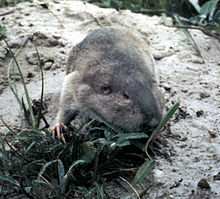Texas pocket gopher
| Texas pocket gopher | |
|---|---|

| |
| Scientific classification | |
| Domain: | Eukaryota |
| Kingdom: | Animalia |
| Phylum: | Chordata |
| Class: | Mammalia |
| Order: | Rodentia |
| Family: | Geomyidae |
| Genus: | Geomys |
| Species: | G. personatus
|
| Binomial name | |
| Geomys personatus F. W. True, 1889
| |
The Texas pocket gopher (Geomys personatus) is a species of
Description
Males grow to a length of about 32 cm (12.6 in) including a tail of about 11 cm (4.3 in). Females are slightly smaller and both sexes weigh about 400 grams (14 oz). The dorsal surface is a dull greyish-brown and the ventral surface is whitish with darker patches. There is very little hair on the tail especially near the tip. The upper incisors have a pair of grooves.[3]
Distribution
The Texas pocket gopher is found in southern
Behavior
A single Texas pocket gopher occupies a burrow system that may have short side branches and about 30 m (98 ft) of passages. It defends its burrow against intruders, emitting a wheezy call and gnashing its teeth.[3] It mainly stays underground and plugs the surface entrances with soil.
Little is known about the reproductive behavior of this species but it appears to breed at any time of year. Litters of from one to five young have been recorded and there are believed to be up to two litters in the year.[3]
Status
The Texas pocket gopher has a wide range and is common in at least part of that range, with a patchy distribution attributable to its requirement for loose, sandy soils in which to burrow. The
References
- ^ . Retrieved 13 November 2021.
- OCLC 62265494.
- ^ a b c d e f "Texan Pocket Gopher". The Mammals of Texas: Rodents. NSRL: Museum of Texas Tech University. Retrieved 4 July 2014.
- . Retrieved 12 December 2023.
- ^ "Geomys personatus: Texas Pocket Gopher". North American Mammals. Smithsonian National Museum of Natural History. Retrieved 4 July 2014.

